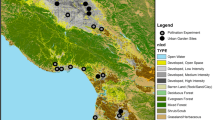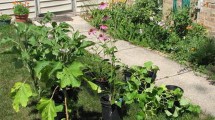Abstract
Urban landscapes are often florally rich due to extensive management of cultivated plants around the city. High abundance and diversity of these floral resources has been linked to more abundant and diverse pollinator communities, but little is known about how urban pollinators select from the wide variety of available flowers. This study provides unique insight into urban plant-pollinator interactions by examining how many plant taxa, and which taxa, are visited by pollinators. Over a three-year period, we observed foraging of urban pollinators across 63 neighborhoods in Chicago, Illinois (USA). We observed 1815 plant-pollinator interactions between 24 pollinator morpho-types and 106 plant taxa. An additional 57 plant taxa were flowering but not visited by pollinators. On average, each pollinator morpho-type visited 19 plant taxa, and most pollinators showed generalist tendencies. We identified 42 plant taxa that were visited by more pollinator morpho-types than their floral abundance would predict; we call these ‘highly attractive’ plants. In general, perennial and native plants received more pollinator visits than their counterparts, and ornamental plants were visited by more species than unintentional ‘weeds’. However, the two most-visited plant taxa were non-native, perennial weeds. Our results suggest that many flowering plants in cities are not visited by pollinators. Furthermore, the plant-pollinator network could be reduced to only four plant taxa without losing any pollinator morpho-types. To enhance urban pollinator conservation, urban residents can select ornamental plants from our list of ‘highly attractive’ plant taxa, or can allow some of the highly attractive ‘weeds’ to persist in their gardens.





Similar content being viewed by others
References
Aronson MFJ, Handel SN, La Puma IP, Clemants SE (2015) Urbanization promotes non-native woody species and diverse plant assemblages in New York metropolitan region. Urban Ecosyst 18:31–45. https://doi.org/10.1007/s11252-014-0382-z
Baldock KCR, Goddard MA, Hicks DM, Kunin WE, Mitschunas N, Osgathorpe LM, Potts SG, Robertson KM, Scott AV, Stone GN, Vaughan IP, Memmott J (2015) Where is the UK’s pollinator biodiversity? The importance of urban areas for flower visiting insects. Proc R Soc Lond B 282:20142849. https://doi.org/10.1098/rspb.2014.2849
Bascompte J, Jordano P, Melian CJ, Olseson JM (2003) The nested assembly of plant–animal mutualistic networks. Proc Natl Acad Sci 100:9383–9387. https://doi.org/10.1073/pnas.1633576100
Biesmeijer JC, Roberts SPM, Reemer M, Ohlemuller R, Edwards M, Peeters T, Schaffers AP, Potts SG, Kleukers R, Thomas CD, Settele J, Kunin WE (2006) Parallel declines in pollinators and insect-pollinated plants in Britain and the Netherlands. Science 313:351–354. https://doi.org/10.1126/science.1127863
Blüthgen N, Klein A-M (2011) Functional complementarity and specialisation: the role of biodiversity in plant–pollinator interactions. Basic Appl Ecol 12:282–291
Bluthgen N, Menzel F, Bluthgen N (2006) Measuring specialization in species interaction networks. BMC Ecol 6:9. https://doi.org/10.1186/1472-6785-6-9
Cane JH, Tepedino VJ (2001) Causes and extent of declines among native North American invertebrate pollinators: detection, evidence, and consequences. Conserv Ecol 5(1):1 [online] URL: http://www.consecol.org/vol5/iss1/art1
Chrobock T, Winiger P, Fischer M, van Kleunen M (2013) The cobblers stick to their lasts: pollinators prefer native over alien plant species in a multi-species experiment. Biol Invasions 15:2577–2588. https://doi.org/10.1007/s10530-013-0474-3
Corbet SA, Bee J, Dasmahapatra K, Gale S, Gorringe E, La Ferla B, Moorhouse T, Trevail A, Van Bergen Y, Vorontsova M (2001) Native or exotic? Double or single? Evaluating plants for pollinator friendly gardens. Ann Bot 87:219–232. https://doi.org/10.1006/anbo.2000.1322
Dormann CF, Frund J, Bluthgen N, Gruber B (2009) Indices, graphs and null models: analyzing bipartite ecological networks. Open Ecol J 2:7–24
Frankie GW, Thorp RW, Schindler M, Hernandez J, Ertter B, Rizzardi M (2005) Ecological patterns of bees and their host ornamental flowers in two northern California cities. J Kansas Entomol Soc 78:227–246. https://doi.org/10.2317/0407.08.1
Garbuzov M, Ratnieks FLW (2014) Quantifying variation among garden plants in attractiveness to bees and other flower-visiting insects. Funct Ecol 28:364–374. https://doi.org/10.1111/1365-2435.12178
Garbuzov M, Samuelson EEW, Ratnieks FLW (2015) Survey of insect visitation of ornamental flowers in Southover grange garden, Lewes, UK. Insect Sci 22:700–705
Garbuzov M, Alton K, Ratnieks FLW (2017) Most ornamental plants on sale in garden centres are unattractive to flower-visiting insects. PeerJ 5:e3066. https://doi.org/10.7717/peerj.3066
Garibaldi LA, Aizen MA, Klein AM, Cunningham SA, Harde LD (2011) Global growth and stability of agricultural yield decrease with pollinator dependence. Proc Natl Acad Sci USA 108:5909–5914
Geslin B, Gauzens B, Thebault E, Dajoz I (2013) Plant pollinator networks along a gradient of urbanisation. PLoS One 8:e63421. https://doi.org/10.1371/journal.pone.0063421
Giurfa M, Dafni A, Neal PR (1999) Floral symmetry and its role in plant-pollinator systems. Int J Plant Sci 160:S41–S50
Goulson D, Nicholls E, Botís ELR (2015) Bee declines driven by combined stress from parasites, pesticides, and lack of flowers. Science 347:1255957
Hall DM, Camilo GR, Tonietto RK, Ollerton J, Ahrné K, Arduser M, Ascher JS, Baldock KCR, Fowler R, Frankie G, Goulson D, Gunnarsson B, Hanley ME, Jackson JI, Langellotto G, Lowenstein D, Minor ES, Philpott SM, Potts SG, Sirohi MH, Spevak EM, Stone GN, Threlfall CG (2017) The city as a refuge for insect pollinators. Conserv Biol 31:24–29
Harmon-Threatt AN, Hendrix SD (2015) Prairie restorations and bees: the potential ability of seed mixes to foster native bee communities. Basic Appl Ecol 16:64–72. https://doi.org/10.1016/j.baae.2014.11.001
Harrison T, Winfree R (2015) Urban drivers of plant-pollinator interactions. Funct Ecol 29:879–888. https://doi.org/10.1111/1365-2435.12486
Hennig EI, Ghazoul J (2011) Plant-pollinator interactions within the urban environment. Perspect Plant Ecol 13:137–150. https://doi.org/10.1016/j.ppees.2011.03.003
Herrera CM, Pellmyr O (2002) Plant-animal interactions: an evolutionary approach. Blackwell Science, Oxford
Hicks DM, Ouvrard P, Baldock KCR, Baude M, Goddard MA, Kunin WE, Mitschunas N, Memmott J, Morse H, Nikolitsi M, Osgathorpe LM, Potts SG, Robertson KM, Scott AV, Sinclair F, Westbury DB, Stone GN (2016) Food for pollinators: quantifying the nectar and pollen resources of urban flower meadows. PLoS One 11:e0158117. https://doi.org/10.1371/journal.pone.0158117
Hülsmann M, von Wehrden H, Klein A, Leonhardt SD (2015) Plant diversity and composition compensate for negative effects of urbanization on foraging bumble bees. Apidologie 46:760–770. https://doi.org/10.1007/s13592-015-0366-x
Jędrzejewska-Szmek K, Zych M (2013) Flower-visitor and pollen transport networks in a large city: structure and properties. Arthropod Plant Interact 7:503–516
Knapp S, Dinsmore L, Fissore C, Hobbie SE, Jakobsdottir I, Kattge J, King JY, Klotz S, McFadden JP, Cavender-Bares J (2012) Phylogenetic and functional characteristics of household yard floras and their changes along an urbanization gradient. Ecology 93:S83–S98. https://doi.org/10.1890/11-0392.1
Kremen C, Williams NM, Thorp RW (2002) Crop pollination from native bees at risk from agricultural intensification. PNAS 99:16812–16816
Larson BMH, Kevan PG, Inouye D (2001) Flies and flowers: taxonomic diversity of anthophiles and pollinators. Can Entomol 133:439–465
Larson JL, Kesheimer AJ, Potter DA (2014) Pollinator assemblages on dandelions and white clover in urban and suburban lawns. J Insect Conserv 18:863–873. https://doi.org/10.1007/s10841-014-9694-9
Loram AL, Warren P, Thompson K, Gaston K (2011) Urban domestic gardens: the effects of human interventions on garden composition. Environ Manag 48:808–824. https://doi.org/10.1007/s00267-011-9723-3
Lowenstein DM, Minor ES (2016) Diversity in flowering plants and their characteristics: integrating humans as a driver of urban floral resources. Urban Ecosyst 19:1735–1748. https://doi.org/10.1007/s11252-016-0563-z
Lowenstein DM, Matteson KC, Xiao I, Silva AM, Minor EM (2014) Human, bees, and pollination services in the city: the case of Chicago, IL (USA). Biodivers Conserv 23:2857–2874. https://doi.org/10.1007/s10531-014-0752-0
MacIvor JS, Cabral JM, Packer L (2014) Pollen specialization by solitary bees in an urban landscape. Urban Ecosyst 17:139–147. https://doi.org/10.1007/s11252-013-0321-4
Matteson KC, Langellotto GA (2009) Bumble bee abundance in New York City community gardens: implications for urban agriculture. CATE 2:5
Matteson KC, Langellotto GA (2011) Small scale additions of native plants fail to increase beneficial insect richness in urban gardens. Insect Conserv Divers 4:89–98. https://doi.org/10.1111/j.1752-4598.2010.00103.x
Matteson KC, Ascher JS, Langellotto GA (2008) Bee richness and abundance in new York City urban gardens. Ann Entomol Soc Am 101:140–150
Moretti M, de Bello F, Roberts SPM, Potts SG (2009) Taxonomical vs. functional responses of bee communities to fire in two contrasting climatic regions. J Anim Ecol 78:98–108
Ollerton J (2017) Pollinator diversity: distribution, ecological function, and conservation. Annu Rev Ecol Evol Syst 48:353–376
Ollerton J, Winfree R, Tarrant S (2011) How many flowering plants are pollinated by animals? Oikos 120:321–326
Petanidou T, Kallimanis AS, Tzanopoulos J, Sgardelis SP, Pantis JD (2008) Long-term observation of a pollination network: fluctuation in species and interactions, relative invariance of network structure and implications for estimates of specialization. Ecol Lett 11:564–575. https://doi.org/10.1111/j.1461-0248.2008.01170.x
Potts SG, Biesmeijer JC, Kremen C, Neumann P, Schweiger O, Kunin WE (2010) Global pollinator declines: trends, impacts and drivers. Trends Ecol Evol 25:345–353
R Development Core Team (2015) R: a language and environment for statistical computing. R Foundation for Statistical Computing, Vienna
Razanajatovo M, Föhr C, Fischer M, Prati D, van Kleunen M (2015) Non-naturalized alien plants receive fewer flower visits than naturalized and native plants in a Swiss botanical garden. Biol Conserv 182:109–116
Rollin O, Benelli G, Benvenuti S, Decourtye A, Wratten SD, Canale A, Desneux N (2016) Weed-insect pollinator networks as bio-indicators of ecological sustainability in agriculture. A review. Agron Sustain Dev 36:8. https://doi.org/10.1007/s13593-015-0342-x
Salisbury A, Armitage J, Bostock H, Perry J, Tatchell M, Thompson K (2015) Enhancing gardens as habitats for flower-visiting aerial insects (pollinators): should we plant native or exotic species? J Appl Ecol 52:1156–1164
Schirmel J, Bundschuh M, Entling MH, Kowarik I, Buchholz S (2015) Impacts of invasive plants on resident animals across ecosystems, taxa, and feeding types: a global assessment. Glob Chang Biol 22:594–603
Sheffield CS, Dumesh S, Cheryomina M (2011) Hylaeus punctatus, a bee species new to Canada with notes on other non-native species. J Ent Soc Ont 142:29–43
Theodorou P, Albig K, Radzevičiūtė R, Settele J, Schweiger O, Murray TE, Paxton RJ (2017) The structure of flower visitor networks in relation to pollination across an agricultural to urban gradient. Funct Ecol 31:838–847. https://doi.org/10.1111/1365-2435.12803
Tuell JK, Fiedler AK, Landis D, Isaacs R (2008) Visitation by wild and managed bees to eastern U.S. native plants for use in conservation programs. Environ Entomol 37:707–718
Vázquez DP, Morris WF, Jordano P (2005) Interaction frequency as a surrogate for the total effect of animal mutualists on plants. Ecol Lett 8:1088–1094
Vázquez DP, Bluthgen N, Cagnolo L, Chacoff NP (2009) Uniting pattern and process in plant-animal mutualistic networks: a review. Ann Bot 103:1445–1457. https://doi.org/10.1093/aob/mcp057
Waser NM, Chittka L, Price MV, Williams NM, Ollerton J (1996) Generalization in pollination systems and why it matters. Ecology 77:1043–1060. https://doi.org/10.2307/2265575
Williams NM, Cariveau D, Winfree R, Kremen C (2011) Bees in disturbed habitats use, but do not prefer, alien plants. Basic Appl Ecol 12:332–341. https://doi.org/10.1016/j.baae.2010.11.008
Zanette LRS, Martins RP, Ribeiro SP (2005) Effects of urbanization on Neotropical wasp and bee assemblages in a Brazilian metropolis. Landsc Urban Plan 71:105–121
Acknowledgements
The authors thank Michelle Budniak, Dragan Dragas, Sophie Huang, and Tabitha Paroongsup who helped with data collection in urban neighborhoods. We thank Stuart Wagenius for comments on an earlier draft of this manuscript. Several anonymous reviewers provided useful comments that improved the manuscript. Funding was provided by NSF Proposal: DEB 1120376.
Author information
Authors and Affiliations
Corresponding author
Ethics declarations
Conflict of interest
The authors declare that they have no conflict of interest.
Electronic supplementary material
ESM 1
(DOCX 720 kb)
Rights and permissions
About this article
Cite this article
Lowenstein, D.M., Matteson, K.C. & Minor, E.S. Evaluating the dependence of urban pollinators on ornamental, non-native, and ‘weedy’ floral resources. Urban Ecosyst 22, 293–302 (2019). https://doi.org/10.1007/s11252-018-0817-z
Published:
Issue Date:
DOI: https://doi.org/10.1007/s11252-018-0817-z




